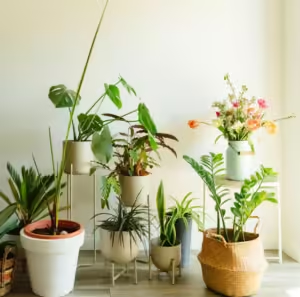Growing plants indoors is an enriching and therapeutic hobby that brings nature into your home, purifies the air, and creates a beautiful, calming atmosphere. Whether you’re interested in starting an indoor herb garden, caring for lush foliage, or growing flowering plants, this guide will take you through every step to ensure your indoor plants thrive.
In this blog, we will cover everything from choosing the right plants and understanding their needs to troubleshooting common problems and creating the perfect environment. Whether you’re a beginner or an experienced gardener, this comprehensive guide will help you develop a flourishing indoor garden.
- Choosing the Right Plants for Your Home
The first and perhaps most crucial step in growing indoor plants is selecting the right plants. Different plants have varying requirements in terms of light, humidity, temperature, and care. Here are some popular categories of indoor plants:
- Low-Maintenance Plants
If you’re new to indoor gardening, it’s wise to start with plants that are low-maintenance. These plants are forgiving and can thrive even if you forget to water them occasionally.
Snake Plant (Sansevieria): Known for its resilience, the snake plant can tolerate low light and irregular watering.
Spider Plant (Chlorophytum comosum): Easy to care for, spider plants are great for beginners and have air-purifying qualities.
ZZ Plant (Zamioculcas zamiifolia): It thrives in low light and requires minimal water, making it perfect for busy individuals.
- Flowering Plants
Flowering plants add colour and beauty to your home. However, most flowering plants require more attention and care.
Peace Lily (Spathiphyllum): This popular plant blooms with white flowers and is also great for purifying the air.
African Violet (Saintpaulia): A compact plant with vibrant purple or pink blooms, African violets thrive indoors with the right care.
Orchids (Orchidaceae): While orchids are considered more challenging, their stunning flowers make the effort worthwhile.
- Herbs
Growing herbs indoors is both practical and rewarding, especially for those who enjoy cooking. Common herbs that do well indoors include:
Basil: Needs plenty of sunlight and regular watering.
Mint: Thrives in partial shade and requires regular moisture.
Thyme: A drought-tolerant herb that does well in sunny spots.
- Succulents and Cacti
Succulents and cacti are popular due to their unique appearance and minimal water needs. Some examples include:
Aloe Vera: Known for its healing properties, aloe vera is a succulent that grows well indoors.
Echeveria: These rosette-shaped succulents come in a variety of colors and require very little water.
Cactus: Cacti are hardy, require minimal care, and are perfect for sunny windowsills.
- Understanding Light Requirements
Light is one of the most important factors for the health of indoor plants. Different plants have different light needs, and providing the right amount of light is crucial for their growth.
- Types of Light Exposure
Direct Sunlight: This is the brightest light, coming directly from the sun. Plants like succulents and cacti need direct sunlight.
Indirect Bright Light: This is where the light doesn’t hit the plant directly but the room is still bright. Many tropical plants like peace lilies and philodendrons thrive in indirect light.
Low Light: Low-light conditions occur in rooms with north-facing windows or spaces far from windows. Snake plants and ZZ plants can tolerate low-light environments.
- Positioning Your Plants
East-facing windows provide soft morning light, ideal for many indoor plants.
South-facing windows receive the most sunlight throughout the day, perfect for sun-loving plants like succulents.
West-facing windows get bright afternoon sunlight, which can be harsh, so it’s ideal for plants that tolerate direct sunlight.
North-facing windows offer the least light, so only low-light plants should be placed near them.
- Supplemental Lighting
If your home doesn’t have adequate natural light, you can use grow lights. These lights mimic the spectrum of natural sunlight and can be essential during the winter months when daylight is limited. LED grow lights are energy-efficient and widely used by indoor gardeners.
- Watering Your Indoor Plants
Watering is often the most misunderstood part of indoor gardening. Overwatering is a common mistake that can lead to root rot, while underwatering can cause wilting and browning of leaves.
- Understanding Water Needs
Different plants have varying water requirements. Some plants, like succulents, thrive with minimal water, while others, like ferns, require constant moisture. Here’s a general guide:
Drought-tolerant plants (e.g., cacti, succulents): Water once the soil is completely dry.
Medium water needs (e.g., peace lilies, philodendrons): Water when the top inch of soil feels dry.
High water needs (e.g., ferns, calatheas): Water when the top layer of soil is slightly dry but ensure the soil remains moist.
- Watering Techniques
Bottom watering: This method involves placing the pot in a tray of water, allowing the plant to absorb moisture from the bottom. It ensures that the roots get hydrated without over-saturating the soil.
Top watering: Water your plants from the top, ensuring that the water reaches the roots evenly. Let excess water drain out of the bottom of the pot.
Make sure to water plants with room-temperature water and avoid cold water, as it can shock the plant’s roots.
- Choosing the Right Potting Mix
Indoor plants generally do not thrive in regular garden soil because it tends to be too dense. A well-draining potting mix is essential for ensuring the roots get enough air and prevent waterlogging.
- Types of Potting Mix
General-purpose potting mix: Suitable for most indoor plants. It usually contains peat moss, vermiculite, and perlite for good drainage.
Cactus and succulent mix: This mix is designed to drain quickly, which is crucial for drought-tolerant plants.
Orchid mix: Orchids need a mix that provides ample airflow, so it’s often composed of bark, perlite, and charcoal.
- Adding Amendments
To improve drainage or aeration, you can add amendments like:
Perlite: A volcanic rock that helps with drainage.
Vermiculite: A mineral that retains moisture while providing aeration.
Coco coir: A sustainable alternative to peat moss, coco coir improves water retention while still allowing for drainage.
- Humidity and Temperature Considerations
Most indoor plants are tropical in nature, and they thrive in environments with higher humidity. Here’s how to manage the humidity and temperature indoors:
- Increasing Humidity
Use a humidifier: A humidifier is the best way to increase humidity, especially in the winter when indoor heating dries the air.
Group plants together: Plants naturally release moisture through a process called transpiration. By grouping plants, you can create a more humid microclimate.
Mist your plants: Lightly mist the leaves of plants that prefer high humidity, such as ferns and calatheas.
Use pebble trays: Place plants on trays filled with water and pebbles. As the water evaporates, it increases the humidity around the plants.
- Temperature Preferences
Most indoor plants prefer temperatures between 65°F and 75°F (18°C and 24°C). Avoid placing plants near drafts, heating vents, or air conditioners, as sudden temperature changes can stress the plants.
- Fertilizing Your Indoor Plants
Fertilizing is essential for healthy plant growth, but too much fertilizer can burn the roots and damage the plant. Different plants have different nutritional needs, so it’s important to choose the right type of fertilizer.
- Types of Fertilizers
Liquid fertilizers: These are easy to use and can be mixed with water for application during regular watering.
Slow-release fertilizers: These are granules that are mixed into the soil and provide nutrients over time.
Organic fertilizers: Made from natural ingredients, organic fertilizers are slow-acting but improve soil health over time.
- How Often to Fertilize
Most indoor plants only need fertilizing during the growing season, typically spring and summer. Follow the instructions on the fertilizer package, but a general rule is to fertilize once a month during the growing season. For low-maintenance plants, fertilizing every 6-8 weeks is usually sufficient.
- Pruning and Repotting
Regular maintenance such as pruning and repotting keeps your plants healthy and encourages new growth.
- Pruning
Pruning involves removing dead or yellowing leaves, as well as trimming back overgrown branches or stems. This helps the plant focus its energy on healthy growth. You can also prune to shape the plant or control its size.
- Repotting
Plants outgrow their pots over time, and when this happens, it’s important to repot them into a larger container. Signs that a plant needs repotting include roots growing out of the drainage holes, slow growth, and water running through the pot too quickly.
When to repot: Repot most indoor plants every 1-2 years, preferably during the growing season (spring or summer).
How to repot: Gently remove the plant from its current pot, loosen the roots, and place it in a slightly larger pot with fresh potting mix.
- Pest Control
Indoor plants are susceptible to pests like spider mites, aphids, and fungus gnats. Early detection and treatment are key to preventing infestations from spreading.
- Common Indoor Plant Pests
Spider mites: These tiny pests are usually found on the underside of leaves and create fine webbing.
Aphids: Aphids are small, pear-shaped insects that can suck the sap from your plant.
Fungus gnats: These pests are small, mosquito-like insects that lay eggs in moist soil.
- How to Treat Pests
Neem oil: A natural insecticide that is safe for most indoor plants.
Insecticidal soap: An effective solution for killing pests without harming plants.
Sticky traps: Useful for catching flying pests like fungus gnats.
- Creating an Indoor Garden Design
Once you’ve mastered plant care, you can focus on creating an aesthetically pleasing indoor garden. Here are some ideas:
- Vertical Gardens
Vertical gardens make use of vertical space, perfect for small apartments or homes with limited space. You can use hanging planters, wall-mounted pots, or tiered plant stands.
- Terrariums
Terrariums are enclosed glass containers that create a miniature garden. They’re perfect for small succulents and mosses and require minimal maintenance.
- Indoor Herb Garden
Create a small herb garden in your kitchen using pots or window boxes. Herbs like basil, rosemary, and parsley grow well indoors and provide fresh ingredients for cooking.
- Conclusion
Growing plants in your home is not only a rewarding hobby but also a way to bring nature indoors. With the right plants, proper care, and attention to their needs, you can create a thriving indoor garden that purifies the air, adds beauty to your space, and even provides fresh herbs for your kitchen.
By understanding light, water, soil, and care requirements, you’ll be well on your way to becoming a successful indoor gardener. Start small, experiment with different plants, and enjoy the process of watching your indoor garden flourish!








Leave a Reply